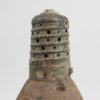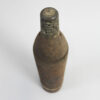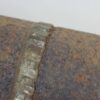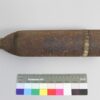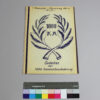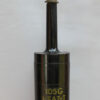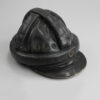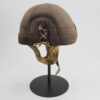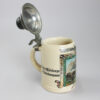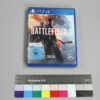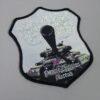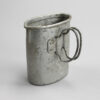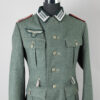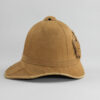French shrapnel grenade 7.5cm
Inventory number: DPM 4.32.5
Shrapnel is a projectile that was developed for use against people, horses and unarmoured vehicles – so-called soft targets. The similar principle of a projectile filled with small parts, the cartouche, has been around since the Middle Ages. However, this was fired straight forward from the barrel of a cannon. The name used today is derived from the British officer Henry Shrapnel, who founded modern shrapnel technology at the end of the 18th century.
As the soldiers on both sides disappeared into narrow corridors with the start of trench warfare in the First World War, the importance of shrapnel diminished: as the lead pellets were ejected in a funnel shape in the direction of flight, similar to a shotgun, they were only of limited use in positional warfare. Instead of shrapnel, fragmentation grenades were therefore used, whose shell casings shattered and threw their fragments in all directions and thus into all areas of the trench. Nevertheless, shrapnel continued to be used, especially on fronts that were still characterized by the classic war of movement, such as the Eastern Front – but also over the trenches of the Western Front.
This French model was built from 1906 to 1929 in several variants for anti-aircraft, turret and field guns. The double fuse 24/31 A M 18, also known as the “beehive fuse” due to its appearance, is particularly striking. This is both an impact fuse and a time fuse. To set the time fuse, one of the holes is pierced with a hole punch, depending on how long the detonation is to be delayed. The maximum burning time of the detonator is 31 seconds. Triggering the detonator ignites a black powder charge in the base, which pushes a pressure plate forward. This ejects the lead pellets inside forward out of the projectile. If the shell reaches the target before the set time has elapsed, it ignites on impact. This does not really achieve the shrapnel effect, but the explosion in the target at least causes some damage.
In order to better control the trajectory, the projectile has a copper guide band that seals the shell in the barrel and improves power transmission. The rifling and fields inside the tube cause the projectile to rotate, resulting in a straighter trajectory. In the band of the fired grenade you can clearly see the cuts and bruises that the soft copper band has received when passing through the rifled tube.
In the Battle of Verdun in 1916 alone, the French army fired an estimated 23 million shells of various types. Even today, shells from all warring parties are found in the ground every day. In the event of a find or the suspicion of a find, the police or the explosive ordnance disposal service must be informed immediately. The found ammunition must not be moved or touched under any circumstances. The possession of ammunition or parts of ammunition that are subject to the Weapons Act, the War Weapons Control Act and the Explosives Act is punishable by law. Our object of the month is an empty, fired ground find that has been inspected and approved by expert personnel.
Incidentally, the above-mentioned karting technique has remained relevant for tanks to this day: For many modern tank guns, there is still cartridged ammunition that can be used against “soft targets”. Today, it is also known as “canister” ammunition and was frequently used in the Korean and Vietnam wars, for example. Among other things, it was used there to “sweep” (empty) enemy tanks: When enemy infantry scaled their own tanks, they were shot at with cartridges: It “swept” the enemy soldiers off the tanks without being able to damage their armor.
Object of the month
(short) stories from the depot
Unfortunately, many objects cannot currently be shown in the exhibition for conservation reasons. Here you will find unusual objects and exciting stories of special pieces from the depot

